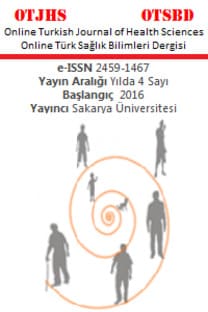Dondurulmuş Çözülmüş Embriyo Transferi Öncesi Günü Progesteron Seviyesinin İn-Vitro Fertilizasyon Başarısına Etkisinin İncelenmesi
Embriyo transferi, gebelik sonuçları, hormon replasman tedavisi
Investigation of the Effect of Progesterone Level on In-Vitro Fertilization Success The Day Before Frozen-Thawed Embryo Transfer
Embryo transfer, hormone replacement therapy, pregnancy outcomes,
___
- Bhattacharya S. Maternal and perinatal outcomes after fresh versus frozen embryo transfer-what is the risk-benefit ratio? Fertility and Sterility. 2016;106(2):241-243.
- Maheshwari A, Pandey S, Shetty A, Hamilton M, Bhattacharya S. Obstetric and perinatal outcomes in singleton pregnancies resulting from the transfer of frozen thawed versus fresh embryos generated through in vitro fertilization treatment: a systematic review and meta-analysis. Fertility and Sterility. 2012;98(2):368-377.
- Wennerholm UB, Henningsen AK, Romundstad LB, Bergh C, Pinborg A, Skjaerven R, et al. Perinatal outcomes of children born after frozen-thawed embryo transfer: a Nordic cohort study from the CoNARTaS group. Human Reproduction (Oxford, England). 2013;28(9):2545-2553.
- Rienzi L, Gracia C, Maggiulli R, et al. Oocyte, embryo and blastocyst cryopreservation in ART: systematic review and meta-analysis comparing slow-freezing versus vitrification to produce evidence for the development of global guidance. Human Reproduction Update. 2017;23(2):139-155.
- Coates A, Kung A, Mounts E, et al. Optimal euploid embryo transfer strategy, fresh versus frozen, after preimplantation genetic screening with next generation sequencing: a randomized controlled trial. Fertility and Sterility. 2017;107(3):723-730.
- Mackens S, Santos-Ribeiro S, van de Vijver A, et al. Frozen embryo transfer: a review on the optimal endometrial preparation and timing. Human Reproduction. 2017;32(11):2234-2242.
- Groenewoud ER, Cohlen BJ, Macklon NS. Programming the endometrium for deferred transfer of cryopreserved embryos: hormone replacement versus modified natural cycles. Fertility and Sterility. 2018;109(5):768-774.
- Yarali H, Polat M, Mumusoglu S, Yarali I, Bozdag G. Preparation of endometrium for frozen embryo replacement cycles: a systematic review and meta-analysis. Journal of Assisted Reproduction and Genetics. 2016;33(10):1287-1304.
- Gellersen B, Brosens JJ. Cyclic decidualization of the human endometrium in reproductive health and failure. Endocrine Reviews. 2014;35(6):851-905.
- Paulson RJ. Hormonal induction of endometrial receptivity. Fertility and Sterility. 2011;96(3):530-535.
- Gaggiotti-Marre S, Martinez F, Coll L, et al. Low serum progesterone the day prior to frozen embryo transfer of euploid embryos is associated with significant reduction in live birth rates. Gynecological endocrinology : the official journal of the International Society of Gynecological Endocrinology. 2019;35(5):439-442.
- Labarta E, Mariani G, Holtmann N, Celada P, Remohí J, Bosch E. Low serum progesterone on the day of embryo transfer is associated with a diminished ongoing pregnancy rate in oocyte donation cycles after artificial endometrial preparation: a prospective study. Human Reproduction. 2017;32(12):2437-2442.
- Alsbjerg B, Thomsen L, Elbaek HO, et al. Progesterone levels on pregnancy test day after hormone replacement therapy-cryopreserved embryo transfer cycles and related reproductive outcomes. Reproductive Biomedicine Online. 2018;37(5):641-647.
- De Ziegler D, Bulletti C, De Monstier B, Jääskeläinen AS. The first uterine pass effect. Annals of the New York Academy of Sciences. 1997;828:291-299.
- Yovich JL, Conceicao JL, Stanger JD, Hinchliffe PM, Keane KN. Mid-luteal serum progesterone concentrations govern implantation rates for cryopreserved embryo transfers conducted under hormone replacement. Reproductive Biomedicine Online. 2015;31(2):180-191.
- Bjuresten K, Landgren BM, Hovatta O, Stavreus-Evers A. Luteal phase progesterone increases live birth rate after frozen embryo transfer. Fertility and Sterility. 2011;95(2):534-537.
- Kim CH, Lee YJ, Lee KH, et al. The effect of luteal phase progesterone supplementation on natural frozen-thawed embryo transfer cycles. Obstetrics & Gynecology Science. 2014;57(4):291-296.
- Brady PC, Kaser DJ, Ginsburg ES, et al. Serum progesterone concentration on day of embryo transfer in donor oocyte cycles. Journal of Assisted Reproduction and Genetics. 2014;31(5):569-575.
- Buvat J, Marcolin G, Guittard C, Herbaut JC, Louvet AL, Dehaene JL. Luteal support after luteinizing hormone-releasing hormone agonist for in vitro fertilization: superiority of human chorionic gonadotropin over oral progesterone. Fertility and Sterility. 1990;53(3):490-494.
- Miles RA, Paulson RJ, Lobo RA, Press MF, Dahmoush L, Sauer MV. Pharmacokinetics and endometrial tissue levels of progesterone after administration by intramuscular and vaginal routes: a comparative study. Fertility and Sterility. 1994;62(3):485-490.
- Khan N, Richter KS, Newsome TL, Blake EJ, Yankov VI. Matched-samples comparison of intramuscular versus vaginal progesterone for luteal phase support after in vitro fertilization and embryo transfer. Fertility and Sterility. 2009;91(6):2445-2450.
- La Rocca C, Carbone F, Longobardi S, Matarese G. The immunology of pregnancy: regulatory T cells control maternal immune tolerance toward the fetus. Immunology Letters. 2014;162(1 Pt A):41-48.
- Bhurke AS, Bagchi IC, Bagchi MK. Progesterone-Regulated endometrial factors controlling implantation. American Journal of Reproductive Immunology. 2016;75(3):237-425.
- Alsbjerg B, Polyzos NP, Elbaek HO, Povlsen BB, Andersen CY, Humaidan P. Increasing vaginal progesterone gel supplementation after frozen-thawed embryo transfer significantly increases the delivery rate. Reproductive Biomedicine Online. 2013;26(2):133-137.
- Salat-Baroux J, Cornet D, Alvarez S, et al. Pregnancies after replacement of frozen-thawed embryos in a donation program. Fertility and Sterility. 1988;49(5):817-821.
- ISSN: 2459-1467
- Yayın Aralığı: Yılda 4 Sayı
- Başlangıç: 2016
- Yayıncı: Oğuz KARABAY
Covid-19 Pandemi Döneminde Ebelik Bölümü Akademisyenlerinin Araştırma Sürecinde Yaşadıkları Sorunlar
Yasemin ERKAL AKSOY, Sema YILMAZ
İyi Bir Sistematik Derleme Nasıl Yazılmalı?
Effect of Sexual Activity in Pregnancy on Beginning of Labor and Pregnancy Complications
Aysun TEKELİ TAŞKÖMÜR, Özlem ERTEN
Ufuk Turan Kürşat KORKMAZ, Barış GÜLHAN
Bir Yenidoğanda PCR İle Tanı Konulan Listeria monocytogenes Menenjiti
Meltem KARABAY, İbrahim CANER, İrem TÜRKOĞLU KUZU KUZU, Mehmet KÖROĞLU
Özcan BUDAK, Seda ÖZKÜLER, SONGÜL DOĞANAY, Nermin AKDEMİR, Mehmet Sühha BOSTANCI, Arif Serhan CEVRİOĞLU, Veysel TOPRAK
Pediatrik Yoğun Bakım Ünitesindeki COVID-19 Hastalarının Değerlendirilmesi
Cansu DURAK, Fatih AYGÜN, Deniz AYGÜN, Ayse AYZİT KİLİNC, Pınar ÖNAL, Haluk ÇOKUĞRAŞ
Klinik Deneyim Yaşayan Hemşirelik Öğrencilerinin Duygu Düzenleme Güçlüklerinin İncelenmesi
NİHAN ALTAN SARIKAYA, Çisem TAŞ, Nisa AKGÜN
Celalettin KORKMAZ, Soner DEMİRBAŞ, Hülya VATANSEV, Sebnem YOSUNKAYA, Turgut TEKE, Adil ZAMANİ, Necdet POYRAZ, Pınar Diydem YILMAZ, Mehmet UYAR
